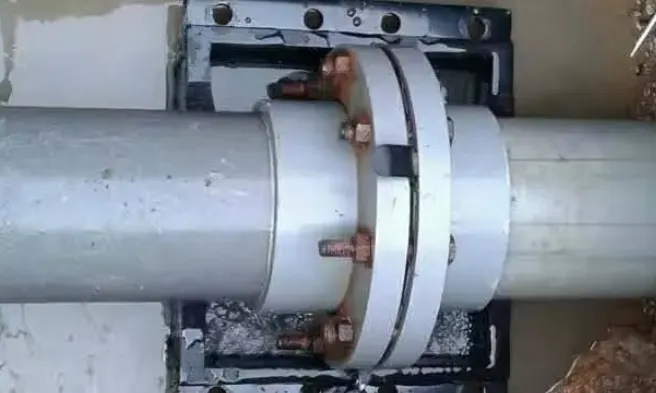Flange is a part mainly used for connection between casing pipe and pipe fittings, valves, equipment, etc., and is one of the indispensable parts in the pipeline system. Flange leakage refers to the leakage of the flange surface of material pipelines and equipment in the petroleum and chemical industries due to the influence of temperature, pressure, and corrosive media. Most chemical companies use pipeline systems in their production, and flanges are indispensable in pipeline systems. After all, flanges can connect pipelines and pipelines in pipeline systems or two devices; in addition, in pipeline systems, flanges are usually used together with flange gaskets and flange bolts to achieve the connection between fixed pipelines and rotating or reciprocating equipment; we also know that if any part of the flange connection is not installed correctly, it will cause problems in the connection and use of the flange, causing the medium in the pipeline to flow out, affecting the production process of the enterprise, and even seriously endangering personal safety; once the flange leaks, it will bring obstacles to the pressure test work, which may affect the construction period and normal production in the future. If the leak is flammable, explosive or corrosive items, it is likely to cause an accident. So, how to solve this problem?

What are the causes of flange leakage?
1. Deviation: Deviation means that the pipe and flange are not vertical or concentric, and the flange surface is not flat. When the internal medium pressure exceeds the load pressure of the gasket, flange leakage occurs. This situation is mainly caused during installation, construction or maintenance, and it is easy to find.
2. Misalignment: Misalignment means that the pipe and flange are vertical, but the two flanges are not concentric, causing the surrounding bolts to not be able to freely penetrate the bolt holes. In the absence of other methods, the only way is to expand the hole or use a smaller bolt to penetrate the bolt hole. This method will reduce the tension of the two flanges, and the sealing surface line of the sealing surface will also deviate, which is very easy to leak.
3. Opening: Opening means that the flange gap is too large, causing external loads, such as axial or bending loads, the gasket will be impacted or vibrated, and the compression force disappears, thereby gradually losing the sealing function and causing the seal to fail.
4. Misaligned holes: Misaligned holes refer to the pipe and flange being concentric, but the distance deviation between the bolt holes of the two flanges is large, which causes stress on the bolts. This force will cause shear force on the bolts, and the bolts will be cut off for a long time, resulting in seal failure.
5. Stress influence: When installing the flange, the docking of the two flanges should be relatively standardized, but in system production, after the pipeline enters the medium, the pipeline temperature changes, the pipeline expands or deforms, and the flange is affected by bending load or shear force, which easily leads to gasket failure.
6. Corrosion influence: Due to the long-term erosion of the gasket by the corrosive medium, the gasket undergoes chemical changes, the gasket begins to soften, and the loss of compression force causes flange leakage.
7. Thermal expansion and contraction:Due to the thermal expansion and contraction of the fluid medium, the bolts expand or contract, and the gasket will have a gap, and the medium will leak through pressure.
How to solve the leakage at flange connection
1. Bolt tightening: Check all bolts to ensure they are tightened. During the operation, a dedicated person should be responsible for supervision and regular inspections to ensure that all bolts are always tightened.
2. Replace the gasket: If the gasket is aged and worn, it should be replaced in time. During the replacement process, attention should be paid to selecting gaskets that meet the specifications and are of reliable quality, and install them as required.
3. Strengthen operating specifications: Formulate and implement relevant operating specifications to ensure that operators follow the requirements when performing flange connection operations. At the same time, strengthen the training of operators and improve their skill level to reduce leakage caused by improper operation.
4. The right one is the best, and materials and types are selected strictly in accordance with the standards. The selected flange material and gasket material must be compatible with the design conditions. The selected flange type and sealing surface type must match the gasket type.
5. Flange protection covers can be used to solve the problem of flange leakage; the so-called flange protection cover is to prevent the accidental splashing of corrosive liquids in the flange connection pipeline from causing damage to personnel or equipment, and to protect the flange, but a suitable protective cover should be selected to avoid aggravating leakage.
In short, understanding the causes and treatment methods of leakage at flange connections is crucial to ensuring the normal operation of the pipeline system. In actual work, the inspection and maintenance of flange connections should be strengthened to detect and solve problems in a timely manner.






 English
English Español
Español بالعربية
بالعربية











 Phone :
Phone :  Whatsapp :
Whatsapp :  Email :
Email : 


